Zetta Elliott's Blog, page 41
November 29, 2015
holiday journey
![Pageflex Persona [document: PRS0000420_00047]](https://i.gr-assets.com/images/S/compressed.photo.goodreads.com/hostedimages/1448843856i/17196232.jpg) When Kelly Starling Lyons asked me to write a guest post for The Brown Bookshelf, I figured I would write about Dayshaun’s Gift. But then weeks went by and Let the Faithful Come was published, so I decided to write about that book instead. I was listening to Pandora, as I often do when I’m writing, and “Don’t Stop Believing” by Journey came on. Since I was writing about my evolving relationship to religion, I decided that would be a suitable title for the essay. I’m not a PK but I grew up in a large, devout Christian family, and the nativity story still thrills me even though I haven’t seen the inside of a church in quite a while…here’s a bit of what I wrote:
When Kelly Starling Lyons asked me to write a guest post for The Brown Bookshelf, I figured I would write about Dayshaun’s Gift. But then weeks went by and Let the Faithful Come was published, so I decided to write about that book instead. I was listening to Pandora, as I often do when I’m writing, and “Don’t Stop Believing” by Journey came on. Since I was writing about my evolving relationship to religion, I decided that would be a suitable title for the essay. I’m not a PK but I grew up in a large, devout Christian family, and the nativity story still thrills me even though I haven’t seen the inside of a church in quite a while…here’s a bit of what I wrote:
I don’t often talk about religion because it no longer plays such a big role in my life. My mother forced me to attend church every Sunday morning (“So long as you live under my roof…”), and I vowed I would never again go to church once I moved out of her house, which is pretty much how things worked out. Once in a while I accompanied my father to Brooklyn Tabernacle, but the megachurch experience wasn’t for me and mostly I just hoped he would take me to Junior’s for lunch once church let out. I still pray every morning and night, and at funerals can usually remember the hymns I sang as a child. But at 43, I find that many of my friends are atheists or prefer to think of themselves as “spiritual” rather than “religious” (according to the Pew Research Center, nearly a quarter of adults in the US identify as “nones” – a term for people who self-identify as atheists or agnostics, or who say their religion is “nothing in particular”). I do have some friends who identify as Christian but they tend to be radical social justice activists and are nothing like those conservatives who think their time and energy is best spent complaining about the design of a coffee cup.
I hope you’ll take a moment to read the entire essay. We’re almost ready to publish the bilingual English/Spanish edition and I’m hoping this book will be a welcome gift for children who feel less than welcome in this country. If you’d like to support refugee kids, you can donate to REFORMA’s Children in Crisis project here.
November 22, 2015
write/read/teach LOCAL
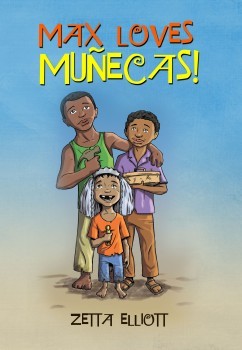 With the holidays fast approaching, I’m seeing the occasional meme on Facebook urging shoppers to support artisans and small business owners instead of patronizing big-box chain stores. Books are a great gift if you have readers in your life, and I would encourage shoppers to “buy local” when it comes to literature as well. I often say that I’m all about “artisanal pickles”–I want to operate on a small scale and realize that means my books will only reach a local market. But that’s ok with me! I was in a chocolate shop last week and saw they had a whole section for chocolate produced here in Brooklyn. Those bars were pricey but at least you know you’re supporting local creators. I wish bookstores would have a comparable section for local indie authors. Today I got a nice email from a 3rd grade teacher I met last year; he has a classroom library and I’m proud to say that my books have their own bin! The kids are completing a unit on book reviews and apparently one student is stuck on a particular book of mine:
With the holidays fast approaching, I’m seeing the occasional meme on Facebook urging shoppers to support artisans and small business owners instead of patronizing big-box chain stores. Books are a great gift if you have readers in your life, and I would encourage shoppers to “buy local” when it comes to literature as well. I often say that I’m all about “artisanal pickles”–I want to operate on a small scale and realize that means my books will only reach a local market. But that’s ok with me! I was in a chocolate shop last week and saw they had a whole section for chocolate produced here in Brooklyn. Those bars were pricey but at least you know you’re supporting local creators. I wish bookstores would have a comparable section for local indie authors. Today I got a nice email from a 3rd grade teacher I met last year; he has a classroom library and I’m proud to say that my books have their own bin! The kids are completing a unit on book reviews and apparently one student is stuck on a particular book of mine:
“Your books are very popular! I’ll be sure to share ___’s review of Max Loves Muñecas when he finishes. He borrowed the book the first week of school and has been re-reading it over and over again ever since.”
![Pageflex Persona [document: PRS0000420_00048]](https://i.gr-assets.com/images/S/compressed.photo.goodreads.com/hostedimages/1448337380i/17126674.jpg) Sometimes I look at my first self-published kids books and cringe; I wish I’d known then what I know now, but I wasn’t confident when it came to art direction and let slide some things that really should have been fixed. But you know what? It doesn’t matter because at least one boy has found value in one of those books. I had Max Loves Muñecas translated into Spanish last summer and will try to get that edition out by the end of the year. Last Xmas I rushed to have copies of An Angel for Mariqua for the family holiday party at Rikers Island; this year I hope to send bilingual and Spanish language books to the children from Central America who are shamefully still in detention here in the US. Billie’s Blues is almost ready to go to print and I’m hoping to have the bilingual English/Spanish edition of Let the Faithful Come ready by the end of the month, too. None of my books is perfect, but perfection isn’t my goal. I’m trying to produce books that resonate with the kids in my community. Last week I presented before 3rd, 4th, and 5th graders at The Weeksville School and the kids were positively buzzing with excitement when my talk ended and they came up to the stage to see my 18 books. I’m at 18 now! And will hit 20 before the new year begins. Last week I received a set of touching letters from the adjudicated boys I met in AR. So many said Ship of Souls was the first book they ever finished reading, and a few said they identified with D since they’re foster kids, too. I was really struck by how many asked about D’s absent father—at least one boy urged me to give D “someone to lean on.” I NEVER regret self-publishing—never—because my stories wouldn’t be out in the world if I hadn’t taken a deep breath and blown those seeds into the wind…
Sometimes I look at my first self-published kids books and cringe; I wish I’d known then what I know now, but I wasn’t confident when it came to art direction and let slide some things that really should have been fixed. But you know what? It doesn’t matter because at least one boy has found value in one of those books. I had Max Loves Muñecas translated into Spanish last summer and will try to get that edition out by the end of the year. Last Xmas I rushed to have copies of An Angel for Mariqua for the family holiday party at Rikers Island; this year I hope to send bilingual and Spanish language books to the children from Central America who are shamefully still in detention here in the US. Billie’s Blues is almost ready to go to print and I’m hoping to have the bilingual English/Spanish edition of Let the Faithful Come ready by the end of the month, too. None of my books is perfect, but perfection isn’t my goal. I’m trying to produce books that resonate with the kids in my community. Last week I presented before 3rd, 4th, and 5th graders at The Weeksville School and the kids were positively buzzing with excitement when my talk ended and they came up to the stage to see my 18 books. I’m at 18 now! And will hit 20 before the new year begins. Last week I received a set of touching letters from the adjudicated boys I met in AR. So many said Ship of Souls was the first book they ever finished reading, and a few said they identified with D since they’re foster kids, too. I was really struck by how many asked about D’s absent father—at least one boy urged me to give D “someone to lean on.” I NEVER regret self-publishing—never—because my stories wouldn’t be out in the world if I hadn’t taken a deep breath and blown those seeds into the wind…
November 18, 2015
KidsLIVE at the NYPL
Join us tomorrow at the Columbus branch of the NYPL for KidsLIVE! The event is listed for kids 5 and up but since I’m discussing Bird and Ship of Souls, it really should be 8 and up. You can get a preview over at the NYPL blog. Hope to see you tomorrow!
November 13, 2015
give books for the holidays!
Ninth Annual Children’s Book Fair
November 14, 2015
12:00–4:00 p.m.
Martha A. and Robert S. Rubin Pavilion, 1st Floor
Join us for our annual Children’s Book Fair featuring your favorite Brooklyn authors and illustrators. This free event includes storybooks, picture books, graphic novels, and original hands-on art activities for all ages.
Readings and drawing with the illustrators in the Rubin Pavilion:
12:30 p.m. Julia Sarcone-Roach, author and illustrator: The Bear Ate Your Sandwich
1 p.m. Tad Hills, author and illustrator: Duck & Goose Colors
1:30 p.m. Abby Hanlon, author and illustrator: Dory and the Real True Friend
2:30 p.m. Scott Menchin, author: Grandma in Blue with Red Hat
3 p.m. Aaron Meshon, author and illustrator: Tools Rule
3:30 p.m. Michael Hearst, author (Young Adult): Extraordinary People
Other participating authors and illustrators:
Selina Alko, Artie Bennett, Sophie Blackall, Carin Bramsen, Peter Brown, Lauren Castillo, Mike Curato, Laura Lyn DiSiena, Zetta Elliott, Brian Floca, Gilbert Ford, Melanie Hope Greenberg, Meredith Hamilton, John & Wendy, Nancy Krulik, Laura Ljungkvist, Yona McDonough, Christopher Silas Neal, George O’Connor, Kris Poluchowicz, Sean Qualls, Sergio Ruzzier, Daniel Salmieri, Louella San Juan, David Ezra Stein, Julie Sternberg, Naoko Stoop, Heather Swain, Dasha Tolstikova, Lesley Ware, Hyewon Yum
November 12, 2015
stamina
 I learned something about myself last week. After five full days presenting in AR, an unexpected overnight flight delay, and a longer than normal teaching day on Saturday, I came home and crashed on the couch. On Sunday I woke up and realized that I didn’t get a single migraine while I was away, despite the fact that I was socializing more than usual AND having cake every single day. Since quitting my job last year, I’ve averaged just one migraine per month and I attribute that to the fact that I protect my introvert self. I generally try to space my events so that I can fit in a day or two of silence and solitude. I don’t sign up for things that are too taxing, but avoidance has its drawbacks. I’m sure I’ve missed out on key opportunities because I was trying to preserve my “dream time.” And that was the lesson I learned last week—I had a great time in AR and met so many wonderful people; I made important connections and pushed myself to go on when I really wanted to run away and hide. And I did it! I fulfilled my obligations and even enjoyed being out of my comfort zone at times. But I didn’t write. At all. Not on Facebook, not here in the blog. I came home from London with 3000 words of a new novel, but I haven’t written a word since—and don’t ask me about the sequel to Wish. I’ve been home almost a week and I still haven’t got back into my writing routine, and THAT is the price I pay for living a “normal” life. I tell people that I don’t have the stamina to teach full-time like my parents did but the truth is, I simply don’t want to pay that price. I
I learned something about myself last week. After five full days presenting in AR, an unexpected overnight flight delay, and a longer than normal teaching day on Saturday, I came home and crashed on the couch. On Sunday I woke up and realized that I didn’t get a single migraine while I was away, despite the fact that I was socializing more than usual AND having cake every single day. Since quitting my job last year, I’ve averaged just one migraine per month and I attribute that to the fact that I protect my introvert self. I generally try to space my events so that I can fit in a day or two of silence and solitude. I don’t sign up for things that are too taxing, but avoidance has its drawbacks. I’m sure I’ve missed out on key opportunities because I was trying to preserve my “dream time.” And that was the lesson I learned last week—I had a great time in AR and met so many wonderful people; I made important connections and pushed myself to go on when I really wanted to run away and hide. And I did it! I fulfilled my obligations and even enjoyed being out of my comfort zone at times. But I didn’t write. At all. Not on Facebook, not here in the blog. I came home from London with 3000 words of a new novel, but I haven’t written a word since—and don’t ask me about the sequel to Wish. I’ve been home almost a week and I still haven’t got back into my writing routine, and THAT is the price I pay for living a “normal” life. I tell people that I don’t have the stamina to teach full-time like my parents did but the truth is, I simply don’t want to pay that price. I 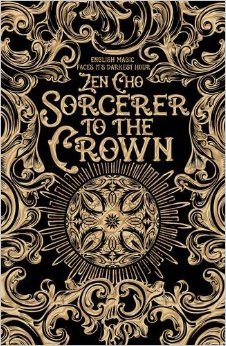 don’t want to surrender the dreamworld that feeds my writing life, and that dreamworld can’t be sustained when I’m out in the real world all the time. Yesterday I spent close to five hours on the subway and instead of grading my students’ homework I immersed myself in Sorcerer to the Crown. A very earnest boy in Conway, AR asked me how I keep coming up with ideas because he found he ran out of ideas before finishing a story. I told him that my imagination was like a sponge that needed to be soaked and wrung dry over and over again. I’m not fond of inscribing books, but I often write: “Feed your imagination, read every day.” I would run out of ideas if I didn’t walk in the garden and run in the park and head up to the Schomburg to see afrofuturistic art. I’m going to try to finish reading this novel in the next couple of days, and then I’m going to go see The Last Witch Hunter with a friend who loves Vin Diesel. I’m going to fill myself with images and ideas (and probably some scones now that it’s cold enough for tea), and then hopefully I’ll sit down and start to write…
don’t want to surrender the dreamworld that feeds my writing life, and that dreamworld can’t be sustained when I’m out in the real world all the time. Yesterday I spent close to five hours on the subway and instead of grading my students’ homework I immersed myself in Sorcerer to the Crown. A very earnest boy in Conway, AR asked me how I keep coming up with ideas because he found he ran out of ideas before finishing a story. I told him that my imagination was like a sponge that needed to be soaked and wrung dry over and over again. I’m not fond of inscribing books, but I often write: “Feed your imagination, read every day.” I would run out of ideas if I didn’t walk in the garden and run in the park and head up to the Schomburg to see afrofuturistic art. I’m going to try to finish reading this novel in the next couple of days, and then I’m going to go see The Last Witch Hunter with a friend who loves Vin Diesel. I’m going to fill myself with images and ideas (and probably some scones now that it’s cold enough for tea), and then hopefully I’ll sit down and start to write…
November 11, 2015
Let the Faithful Come
It’s here! Let the Faithful Come is a special book for the holiday season. Learn more here or check out my latest newsletter. A Spanish-English edition should be ready by Thanksgiving…
November 9, 2015
Tiny Pretty Things

When I finished reading Tiny Pretty Things last summer, I had some questions for Dhonielle Clayton and Sona Charaipotra . They are VERY busy women, but they kindly agreed to take time out of their schedules to answer three pressing questions for me—read on!
ME: I have to say, I was never really interested in ballet until I read your novel! Its release coincided with the ABT’s appointment of Misty Copeland and Stella Abrera as principal dancers, and this happened around the same time that another Black woman athlete (Serena Williams) was being publicly criticized for not being “feminine enough.” Can you talk about your intent in making two of the three lead characters teenage girls of color? Misty has been told she’s “too athletic” but your characters seem to “fit in” rather that pushing against the mold. Did you want your characters of color to disrupt traditional ballet messages and/or images of femininity?
D&S: We were definitely very deliberate in making two of the three protagonists in TINY PRETTY THINGS people of color. That’s CAKE Literary’s mission: to make delicious page turners with a deep, organic layer of diversity to them. The idea is that the diversity is not the plot, but definitely affects the plot. In the world of pre-professional ballet — a world Dhonielle witnessed firsthand while teaching at a ballet conservatory — that diversity already exists, and we decided to stay true to the diversity that really does exist and exalt it. (Rather than say, forcing an Indian girl into that picture because that is Sona’s own background.) There are dancers of color competing at this level, and the experience is certainly different and sometimes difficult for them. We decided to reflect on the racism and microaggressions these dancers of color experience in this world, and to let their backgrounds permeate their experience and worldview. Regarding the idea of a dancer of African-American descent being “too athletic,” that is quietly explored in TPT as well — as Gigi faces comments about her thighs and body type, etc., within the judgments made against her (and internalizes some of these judgments herself). Then there’s the idea that she’s the “flavor of the month” for Mr. K, the creative director, but also that she doesn’t fit the traditional Ballet Blanc ideal. And the idea that Asian dancers are often cast to the side is definitely something June’s experience comments on — she’s neither here nor there, racially, emotionally, casting-wise, so she’s a bit untethered. Both her fellow students and the instructors at the conservatory don’t know quite which box to put her in.
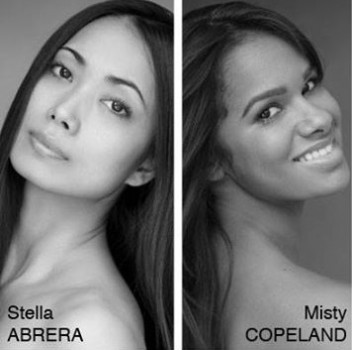 There is this idea of the Ballet Blanc that remains the default to this day. Hopefully, with strides made by dancers like Misty Copeland, Stella Abrera and Hee Seo, this will begin to shift. In this, we’re hoping that TPT reflects a reality, and further propels/normalizes that shift.
There is this idea of the Ballet Blanc that remains the default to this day. Hopefully, with strides made by dancers like Misty Copeland, Stella Abrera and Hee Seo, this will begin to shift. In this, we’re hoping that TPT reflects a reality, and further propels/normalizes that shift.ME: I was really interested in the way you used Henri to menace Bette, though I was troubled at times by his behavior. Were you worried about making him seem like a sexual predator or were his actions “justified” by Bette’s abuse of Cassie? You made sex complicated in this novel; are teen readers ready for that level of complexity?
D&S: Henri’s approach to his revenge on Bette is meant to be troubling. His menace is practiced to the point of being almost casual, and that’s meant to disturb both Bette and the reader. I definitely don’t personally see his actions as justified in any way, and the particular scenes you reference are meant to be intimidating and scary. Yes, Bette’s done some very horrifying things herself, but Henri’s retaliation isn’t justified by it — and I think the power dynamic, in what he knows, and in his sheer strength, is meant to worry the reader. He holds something over her, so she’s afraid to speak out, and she also ponders her own power in this situation. This is reflected in her attempts to use that power in handling her problems with Mr. K. She thinks she knows what she’s doing, but she really has no clue, and I think that’s very teen of her. I think the sad reality is that many teen readers probably understand too well the dynamics at play here, how messed up they are, how she is a victim while also being a villain (in her bullying). It’s meant to make you feel conflicted and to make you think, since female bodies are so much front and center in this world — objects to be commented on, owned and manipulated on so many levels.
ME: Many Black artists have argued that their goal is to represent the full spectrum of Black humanity without worrying about confirming stereotypes or offering only “positive” representations of the race. With your three main characters, were you consciously exploiting or working against stereotypes? Why do we need representations of “mean girls” who aren’t only white?
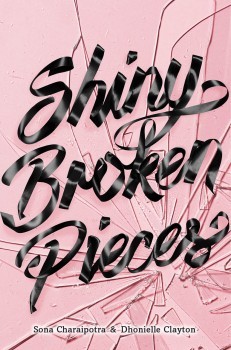 D&S: We were quite deliberate in this as well — we didn’t want to represent the “angry black girl” or the “demure Asian girl,” so we began with turning those tropes around. People frequently say June is probably the most messed up of the characters in the book — but let’s be real, we were pretty equal opportunity on that front. We wanted her to be first and foremost an interesting, complex character — someone you maybe love to hate, but someone you also feel for. Yes, she’s Asian, and so much of her emotional deficit comes from her in-between space, the racism she faces, the lack of information about who she is, the remove she often feels from the culture she’s meant to be a part of. So race informs her, certainly. But so too does experience. Gigi is meant to represent an upper middle class African-American girl who’s had a somewhat privileged, sheltered experience till now — someone we don’t see all that often in teen fiction, but who certainly exists.
D&S: We were quite deliberate in this as well — we didn’t want to represent the “angry black girl” or the “demure Asian girl,” so we began with turning those tropes around. People frequently say June is probably the most messed up of the characters in the book — but let’s be real, we were pretty equal opportunity on that front. We wanted her to be first and foremost an interesting, complex character — someone you maybe love to hate, but someone you also feel for. Yes, she’s Asian, and so much of her emotional deficit comes from her in-between space, the racism she faces, the lack of information about who she is, the remove she often feels from the culture she’s meant to be a part of. So race informs her, certainly. But so too does experience. Gigi is meant to represent an upper middle class African-American girl who’s had a somewhat privileged, sheltered experience till now — someone we don’t see all that often in teen fiction, but who certainly exists.
Thanks, ladies! You can learn more about Dhonielle, Sona, and CAKE Literary here, and look for the sequel Shiny Broken Pieces next summer…
November 5, 2015
highlight
I haven’t slept well this past week, which means I haven’t had energy to blog by the time I reach the hotel at the end of each day. But today was the Arkansas Curriculum Conference and something wonderful happened that I don’t want to forget:
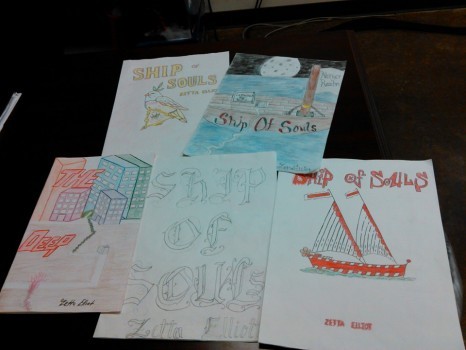 1. The teacher who won a grant to buy copies of Ship of Souls for the boys in detention also won an award! During her acceptance speech, Jill explained how the boys’ interest in the book made the project blossom until my novel was being used across the curriculum—the boys were fully engaged, they learned about archaeology, they even made their own dust jackets for the book (which were amazing!), and fought over who would get to read The Deep next. Apparently they aren’t always attentive, but I had their undivided attention when I visited the detention center on Sunday. I’ve been saying for the past year that I feel I’m planting seeds. There’s really no way to know what kind of impact an author visit might have, but it was so gratifying to hear Jill talk about the boys and to know that Ship of Souls was, for at least some of them, the first book they finished reading. Yesterday I heard from a friend who teaches at Rikers Island; I’m hoping I can visit her class as well.
1. The teacher who won a grant to buy copies of Ship of Souls for the boys in detention also won an award! During her acceptance speech, Jill explained how the boys’ interest in the book made the project blossom until my novel was being used across the curriculum—the boys were fully engaged, they learned about archaeology, they even made their own dust jackets for the book (which were amazing!), and fought over who would get to read The Deep next. Apparently they aren’t always attentive, but I had their undivided attention when I visited the detention center on Sunday. I’ve been saying for the past year that I feel I’m planting seeds. There’s really no way to know what kind of impact an author visit might have, but it was so gratifying to hear Jill talk about the boys and to know that Ship of Souls was, for at least some of them, the first book they finished reading. Yesterday I heard from a friend who teaches at Rikers Island; I’m hoping I can visit her class as well.
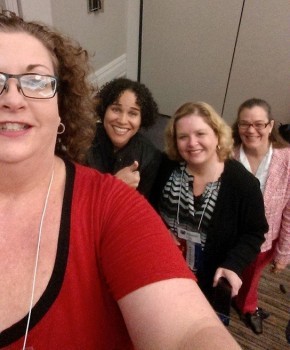 I have to be up at 4am to catch my rescheduled flight so the rest of the recap will have to wait. Dr. Dixie Keyes, outgoing president of ACTELA, worked so hard to make this trip happen and I can’t thank her enough. I met so many wonderful students and educators over the past five days! My keynote wasn’t great—a bit to academicky—but the rest of my sixteen workshops went well, I think, and it’s always wonderful to see kids who are excited about my books. I told everyone about Write Now! Make Books and hope lots of budding writers will publish their own books before long.
I have to be up at 4am to catch my rescheduled flight so the rest of the recap will have to wait. Dr. Dixie Keyes, outgoing president of ACTELA, worked so hard to make this trip happen and I can’t thank her enough. I met so many wonderful students and educators over the past five days! My keynote wasn’t great—a bit to academicky—but the rest of my sixteen workshops went well, I think, and it’s always wonderful to see kids who are excited about my books. I told everyone about Write Now! Make Books and hope lots of budding writers will publish their own books before long.
Ok, it’s just past 8pm but it’s time for bed. Still don’t have my marking done—grades were due last weekend—but I have a 9-hour journey tomorrow so maybe I’ll blog and grade along the way…
nite
z
October 30, 2015
leave the door open
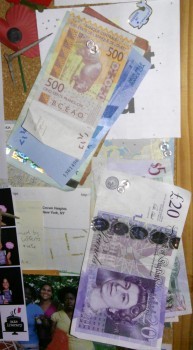 Whenever I come back from a trip abroad, I pin the leftover currency to my bulletin board. In a corner of my bookshelf I stack the coins and stash any transit passes that I might use again down the road. When I left for London last weekend, I had over 30 GBP in my wallet—money that was leftover from my 2013 birthday/research trip to Oxford. I had an Oyster card, too, which I hadn’t used since spending Xmas in London in 2012. Turns out it had 15 GBP on it and that got me around the city—to the Black Cultural Archives in Brixton, and back to the hotel after having high tea at Brown’s Hotel with my friend Mary. I walked a lot while I was in London and I spent a lot of time in the hotel. I came home with over 3000 words written on the new novel and think I can finish it before the end of this year. Everything in London felt easy and there was more than one moment when I realized I was happy! That sounds strange, but I’m so accustomed to being busy—and measuring my productivity—that I don’t always ask myself if I’m happy. A friend is having surgery next week and it’s a procedure that will close one of many doors in her life. We talked tonight about happiness and the importance of knowing what makes you happy; when the nightly news is grim and chronic health issues consume much of your energy, that’s the moment you need to make sure that there’s joy in your life. I’m heading out of town soon—again—and want to make sure that I try to enjoy myself while I’m away. I’ll be working but I’ll also be in a new place, meeting lots of new people. I love being alone, strolling through gardens, daydreaming about ghosts and castles. But if I want to find some joy in every day, then I have to let happiness happen when I may not expect it to appear. I still have money on my Oyster card and I came home with a twenty pound note. I don’t know when I’ll get back to London but it’s good to know the door will still be open…
Whenever I come back from a trip abroad, I pin the leftover currency to my bulletin board. In a corner of my bookshelf I stack the coins and stash any transit passes that I might use again down the road. When I left for London last weekend, I had over 30 GBP in my wallet—money that was leftover from my 2013 birthday/research trip to Oxford. I had an Oyster card, too, which I hadn’t used since spending Xmas in London in 2012. Turns out it had 15 GBP on it and that got me around the city—to the Black Cultural Archives in Brixton, and back to the hotel after having high tea at Brown’s Hotel with my friend Mary. I walked a lot while I was in London and I spent a lot of time in the hotel. I came home with over 3000 words written on the new novel and think I can finish it before the end of this year. Everything in London felt easy and there was more than one moment when I realized I was happy! That sounds strange, but I’m so accustomed to being busy—and measuring my productivity—that I don’t always ask myself if I’m happy. A friend is having surgery next week and it’s a procedure that will close one of many doors in her life. We talked tonight about happiness and the importance of knowing what makes you happy; when the nightly news is grim and chronic health issues consume much of your energy, that’s the moment you need to make sure that there’s joy in your life. I’m heading out of town soon—again—and want to make sure that I try to enjoy myself while I’m away. I’ll be working but I’ll also be in a new place, meeting lots of new people. I love being alone, strolling through gardens, daydreaming about ghosts and castles. But if I want to find some joy in every day, then I have to let happiness happen when I may not expect it to appear. I still have money on my Oyster card and I came home with a twenty pound note. I don’t know when I’ll get back to London but it’s good to know the door will still be open…
October 27, 2015
being me abroad
 Got a slow start this morning, but the fog is lifting and I’m heading back to the Victoria & Albert Museum before meeting a friend for tea at 4pm. With one day left in London, I’m realizing that I might have been too ambitious when composing my To Do list. I spent a magical morning in Windsor yesterday and then connected with an online friend who fights for diversity here in the UK. I’ve written 1500 words on the new City Kids book—The Ghost in the Castle—and I’ve been lugging my laptop around so I can stop and write as needed. Had no sugar on Sunday but overdid it yesterday, which might be why I woke with a headache. Will indulge myself at tea and then try to go sugar-free tomorrow. I saw Hobnobs on sale at the grocery story, though, so may stock up for the future. I’d rather work on the story than blog so will just say that my search for information about Prince Alemayehu led me to two seniors whose enthusiasm and kindness made my day (and made me miss my grandparents terribly). One steward at St. George’s Chapel, Shelagh, directed me to the plaque commemorating the prince’s life; she also told me that Haile Selassie I was named a Knight of the Garter, and another steward (John) helped me locate his plaque, which was no easy task. I’ve been using this article to
Got a slow start this morning, but the fog is lifting and I’m heading back to the Victoria & Albert Museum before meeting a friend for tea at 4pm. With one day left in London, I’m realizing that I might have been too ambitious when composing my To Do list. I spent a magical morning in Windsor yesterday and then connected with an online friend who fights for diversity here in the UK. I’ve written 1500 words on the new City Kids book—The Ghost in the Castle—and I’ve been lugging my laptop around so I can stop and write as needed. Had no sugar on Sunday but overdid it yesterday, which might be why I woke with a headache. Will indulge myself at tea and then try to go sugar-free tomorrow. I saw Hobnobs on sale at the grocery story, though, so may stock up for the future. I’d rather work on the story than blog so will just say that my search for information about Prince Alemayehu led me to two seniors whose enthusiasm and kindness made my day (and made me miss my grandparents terribly). One steward at St. George’s Chapel, Shelagh, directed me to the plaque commemorating the prince’s life; she also told me that Haile Selassie I was named a Knight of the Garter, and another steward (John) helped me locate his plaque, which was no easy task. I’ve been using this article to 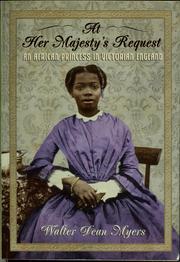 guide my research, and was surprised when Shelagh told me the child’s mother was brought to England with him but died in transit. He was still a captive as far as I’m concerned, but he might have at least had the comfort of a parent to help him adjust to life in England. I think her dress is on display at the V&A so that’s where I’m heading now. I’m reading At Her Majesty’s Request: an African Princess in Victorian England, and plan to introduce Sarah Forbes Bonetta into my story; she seems to have assimilated more easily and traveled between the two continents during her lifetime. Did she know the prince? Would they have been friends or would she have seen him as a rival for the Queen’s favor? I had a lovely birthday and realize that a slow-paced trip is best for me—when I was in Dakar two summers ago I did the same thing: holed up in the hotel, ate in my room, and ventured out once or twice a day to absorb information to use in my book. BBC News was the only English-language channel I could get and so I kept that on as I wrote. Here in London I’m watching Time Team and all the other murder mystery shows that I love. I’m in a bubble with my characters, which include two sisters who have contrary perspectives on being Black and British. I might be able to finish this book by the end of November. And no, I haven’t finished the sequel to Wish but that will happen, too. It will—I promise!
guide my research, and was surprised when Shelagh told me the child’s mother was brought to England with him but died in transit. He was still a captive as far as I’m concerned, but he might have at least had the comfort of a parent to help him adjust to life in England. I think her dress is on display at the V&A so that’s where I’m heading now. I’m reading At Her Majesty’s Request: an African Princess in Victorian England, and plan to introduce Sarah Forbes Bonetta into my story; she seems to have assimilated more easily and traveled between the two continents during her lifetime. Did she know the prince? Would they have been friends or would she have seen him as a rival for the Queen’s favor? I had a lovely birthday and realize that a slow-paced trip is best for me—when I was in Dakar two summers ago I did the same thing: holed up in the hotel, ate in my room, and ventured out once or twice a day to absorb information to use in my book. BBC News was the only English-language channel I could get and so I kept that on as I wrote. Here in London I’m watching Time Team and all the other murder mystery shows that I love. I’m in a bubble with my characters, which include two sisters who have contrary perspectives on being Black and British. I might be able to finish this book by the end of November. And no, I haven’t finished the sequel to Wish but that will happen, too. It will—I promise!

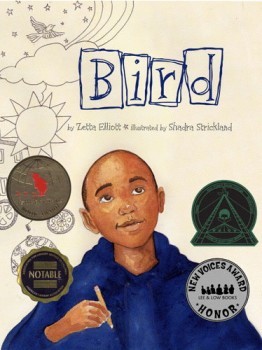
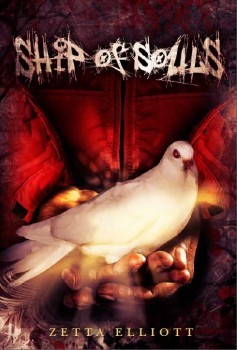
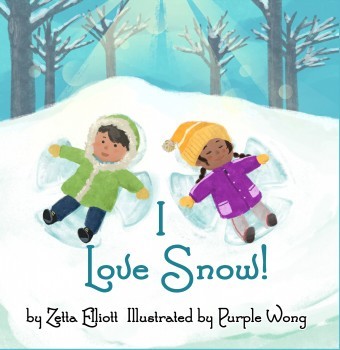
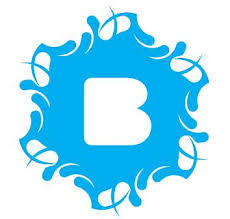
![Pageflex Persona [document: PRS0000420_00047]](https://i.gr-assets.com/images/S/compressed.photo.goodreads.com/hostedimages/1447297803i/16983531._SY540_.jpg)


